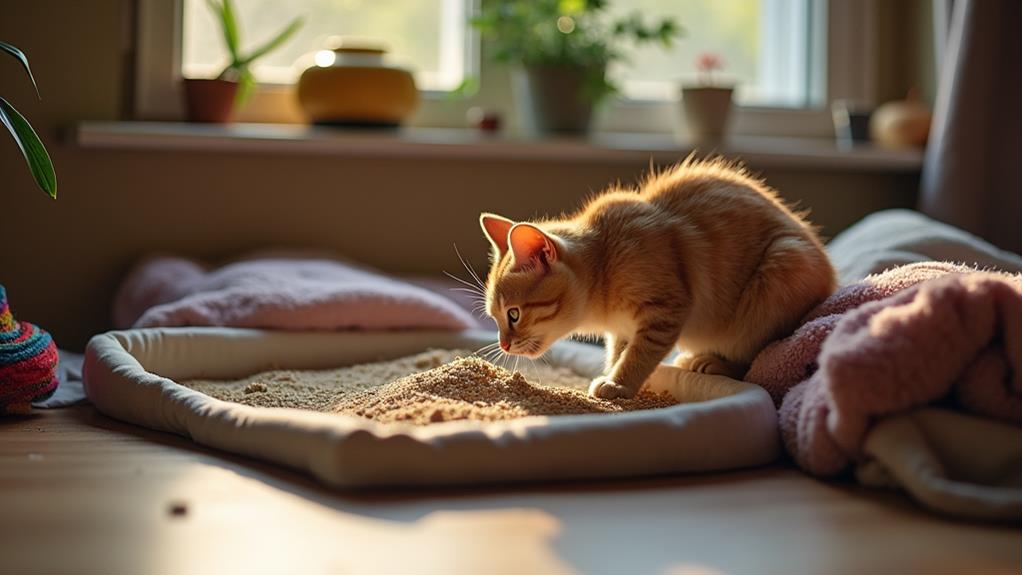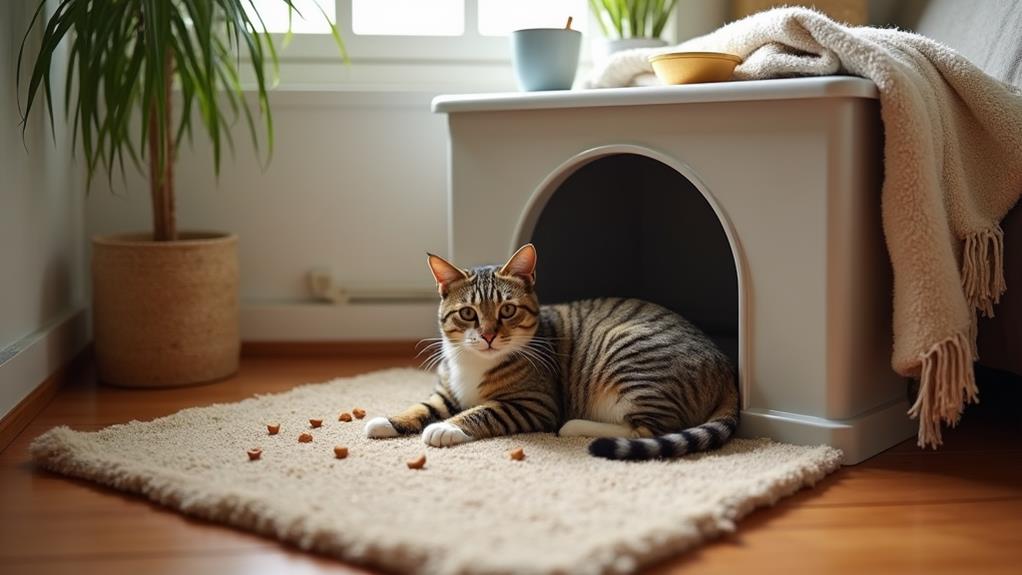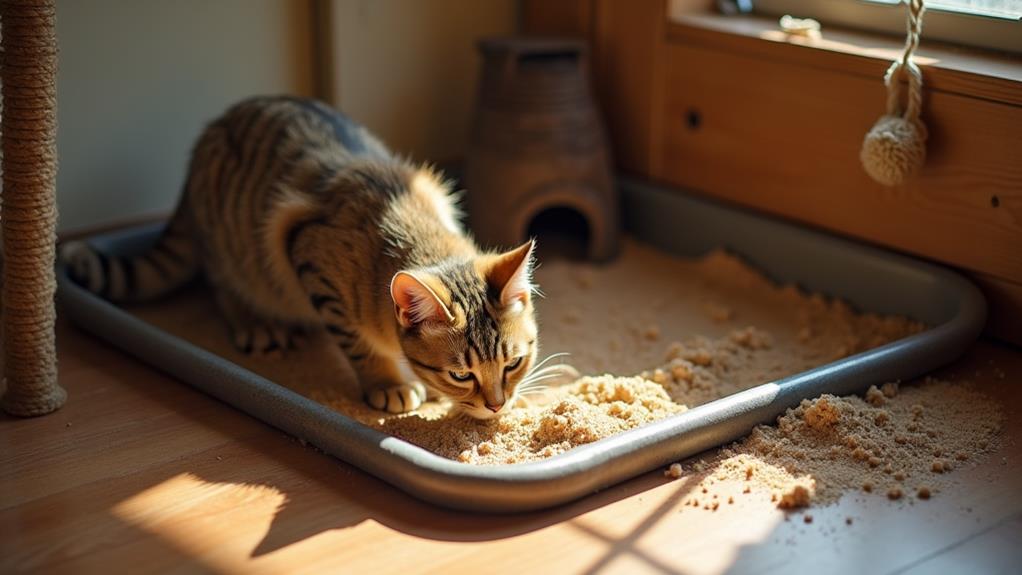How to Get a Feral Cat to Use a Litter Box: Training Tips for Success

Getting a feral cat to use a litter box starts with understanding their natural instincts. Begin by filling the box with potting soil to mimic familiar textures. Place the box in a quiet, private spot and make certain it's large enough for comfort. Regular cleaning and providing multiple boxes help reduce stress. Introduce alternative litters gradually and observe your cat's preferences. Encourage exploration by letting them investigate freely and reward positive behavior with treats or praise. With patience and the right setup, you'll see progress and learn more about creating positive associations and addressing common challenges on this expedition.
Understanding Feral Cat Behavior
Why do feral cats behave the way they do? Feral cats have spent their lives in outdoor environments, where they've naturally eliminated in soil or similar textures. This behavior makes introducing them to a litter box a unique challenge. They're not accustomed to using a litter box, and without maternal guidance, feral kittens often struggle to understand indoor norms. Their instincts as clean animals drive them to seek out familiar, soil-like materials, so using potting soil initially can ease the shift.
Your goal is to create a quiet and secure environment for them. Stress from noise or sudden changes can deter them from exploring and accepting a litter box. When introducing feral cats to indoor living, patience is essential. They might take longer to adapt, but consistent positive reinforcement can make a significant difference. Reward them with treats or affection when they use the litter box correctly, reinforcing the behavior you want to see.
Choosing the Right Litter
Selecting the right litter is vital when moving a feral cat to indoor living. You want to make this change as smooth as possible. Start by using a material the cat might prefer, like potting soil, which mimics the outdoor environment they're accustomed to. This familiar texture can encourage the cat to use the box. Gradually introduce other types of litter, experimenting with natural options like wood bark, corn, or walnut shell to find what works best. Cats often have specific texture preferences, so observing which type your cat prefers is significant.
Once the cat is comfortable with the box, you can shift to unscented clumping litter. Cats tend to favor this type because it allows them to bury their waste effectively. It's vital to maintain a consistent litter type once you find the right one, as frequent changes can confuse the cat and lead to litter box avoidance. Make sure the litter is at least 6cm deep to align with the cat's natural burying instincts. By choosing the right litter and maintaining consistency, you'll encourage regular use and help your feral cat settle into their new indoor life.
Setting Up the Litter Box

After choosing the right litter, it's time to focus on setting up the litter box to promote your feral cat to use it regularly. Start by selecting an open litter box that's large enough for your cat to move comfortably—ideally, it should be the cat's length plus half. This size allows your cat the space it needs to feel secure and unrestricted.
Next, place the litter box in a quiet, private area. Make sure it's away from food and water dishes to reduce stress and promote usage. Feral cats are accustomed to privacy in the wild, so a secluded spot helps meet this natural instinct. Remember, it's essential to have multiple litter boxes available—at least one litter box per cat, plus an extra. This setup minimizes competition and gives your cat options, making it more likely they'll use a litter box.
Maintain cleanliness by scooping the litter box daily and changing the litter monthly. Regular cleaning prevents odors that might deter your cat from using the box. By considering these factors, you can create an environment that meets your cat's needs and promotes regular litter box use.
Creating Positive Associations
To successfully shift a feral cat to using a litter box, it's crucial to create positive associations with the new behavior. Start by incorporating familiar scents into the litter box. You can do this by adding soil and leaves from areas where the cat previously eliminated outdoors. This makes the box more recognizable and comforting. Allow the cat to investigate the litter box freely, without any pressure, so it feels safe and encouraged to use it.
Here are some steps to help your cat learn to use the litter box:
- Use Familiar Scents: Place soil and leaves or even the cat's stool in the litter box. This creates a strong connection between the litter box and its natural bathroom habits.
- Simulate Natural Behavior: Gently stir the regular litter, mimicking the digging behavior that feral cats are accustomed to. This action can intrigue the cat and make the litter box more appealing.
- Provide Positive Reinforcement: Immediately reward the cat with treats or praise after it uses the litter box. This strengthens the positive association, making the cat more likely to return.
Encouraging Exploration

Encouraging a feral cat to examine the litter box is key to helping it feel at ease in its new environment. You need to allow the cat free movement in and out of the litter box. This approach fosters comfort and reduces any anxiety that might be associated with confinement. Remember, restraining the cat inside the box can create negative associations, which you definitely want to avoid.
To encourage investigation, introduce the litter box during natural behaviors, such as after meals or playtime. This timing helps create positive associations with the box's use. You can gently stir the litter to mimic natural digging behavior, which many cats find irresistible. This simple action can entice the cat to examine further.
Monitor the cat for signs of readiness and gradually improve its curiosity by incorporating familiar scents. Consider placing soil or leaves in or around the litter box. These familiar scents can make the new environment feel more like home and less intimidating. By taking these steps, you're setting the stage for your feral cat to comfortably and confidently use the litter box, ensuring a smoother adjustment into its new surroundings.
Maintaining a Clean Environment
Now that your feral cat is showing interest in the litter box, maintaining a clean environment becomes vital to encourage consistent use. Keeping the litter box clean reduces stress for your cat and prevents potential health problems. Here's how you can do it effectively:
- Daily Scooping and Regular Cleaning: Scoop the litter box daily to keep it fresh and inviting for your cat. Every other day, clean the box with unscented detergent to prevent odor buildup. A clean environment motivates your cat to keep using the box.
- Monthly Litter Change: It's significant to change the litter monthly. Fresh litter not only minimizes odors but also guarantees a pleasant experience for your cat. Unscented litter is often preferred, as strong scents can deter your cat from using the box.
- Utilize Enzymatic Cleaners: If your cat has had accidents outside the litter box, use enzymatic cleaners to remove any lingering scents. This discourages your cat from returning to those spots.
Additionally, place the litter box in a quiet, private area away from food and water. Consider surrounding it with puppy pee pads to protect your floors from any spills or accidents. By following these steps, you'll create an inviting space that motivates your cat to use the litter box consistently.
Addressing Common Challenges

Dealing with common challenges when getting a feral cat to use a litter box can be intimidating, but understanding their behavior helps ease the process. Feral cats are creatures of habit, so when they resist using a litter box, it's often due to unfamiliarity. You can help bridge this gap by incorporating soil or leaves from their usual outdoor spots into the box, creating a familiar scent and texture.
Start the training process by gradually introducing different litter types. Begin with potting soil and slowly mix in unscented clumping litter. This gradual change helps the feral cat adjust without overwhelming them. Privacy is key for these cats, so place multiple litter boxes in quiet, secluded areas to reduce stress and encourage use.
Patience is vital; monitor their behavior without rushing the process. A feral cat may take time to adapt, so consistent encouragement is significant. Furthermore, regular cleaning of the litter box is fundamental. A dirty box can lead to avoidance, so maintain cleanliness to promote consistent use. Addressing these challenges with care and understanding paves the way for successful litter box training, ensuring your feral cat feels secure and comfortable in their new environment.
Managing Multi-Cat Dynamics
Training a feral cat to use a litter box can be challenging, but adding the dynamics of a multi-cat household brings another layer of complexity. You need to tackle territorial behaviors and guarantee each cat feels secure. For a smooth changeover, follow these steps:
- Provide Enough Litter Boxes: It's essential to have at least one litter box per cat, plus one extra. This reduces competition and guarantees that if a cat refuses to use one box, they have other options available.
- Choose the Right Locations: Place litter boxes in quiet, accessible areas to help reduce stress. Cats, especially those previously feral, may avoid boxes if they feel threatened by other cats or noise.
- Observe Preferences: Each cat, including a potentially stubborn old cat, might have specific preferences for litter type and box design. Pay attention to these preferences to encourage consistent use.
Regular cleaning is important, as dirty litter boxes can lead to inappropriate elimination. When introducing new cats, do it gradually and guarantee ample resources to minimize stress. By managing these dynamics, you'll help your feral cat feel comfortable and trained to use the litter box confidently.
Retraining Techniques

Retraining a feral cat to use a litter box can be a precise process, but starting with a veterinary checkup is vital to rule out any health issues. Once you've confirmed your cat is healthy, begin by using confinement in a small, manageable space. This area should have a litter box easily accessible so the cat can associate it as the designated bathroom spot. It's important to keep the environment calm to minimize stress, allowing the cat to feel secure and more likely to adopt new habits.
As your cat starts using the litter box consistently, use positive reinforcement to encourage this behavior. Immediately reward them with treats or praise when they use the box successfully. This positive association will help reinforce the desired behavior, making it more likely to stick.
Make certain to monitor your cat's litter box habits closely. Regular observation can help you spot any changes that might indicate stress or discomfort, allowing you to address potential issues promptly. When your cat reliably uses the box, gradually expand their space, always making sure the environment remains calm and stress-free. This methodical approach guarantees successful retraining and a happier cat.
Seeking Veterinary Advice
When working with a feral cat on litter box habits, keeping an eye on their behavior is vital. If your cat consistently avoids the litter box, it could signal underlying health issues. A veterinary examination becomes important in such cases to rule out conditions like urinary tract infections or blockages. Sudden changes in litter box habits, such as frequent accidents, should prompt immediate veterinary consultation. These changes might indicate serious health concerns requiring urgent attention.
To guarantee your cat's well-being and address potential litter box problems, consider these steps:
- Schedule Regular Veterinary Check-Ups: Regular visits to the vet can help monitor your feral cat's health, catching any issues early before they affect litter box habits.
- Monitor for Behavioral Issues: Stress or anxiety can contribute to litter box avoidance. A veterinarian can offer guidance tailored to your cat's specific situation, helping alleviate these issues.
- Watch for Signs of Discomfort: Straining or discomfort while urinating or defecating should be treated as emergencies. Immediate veterinary care might be necessary to address these problems.




